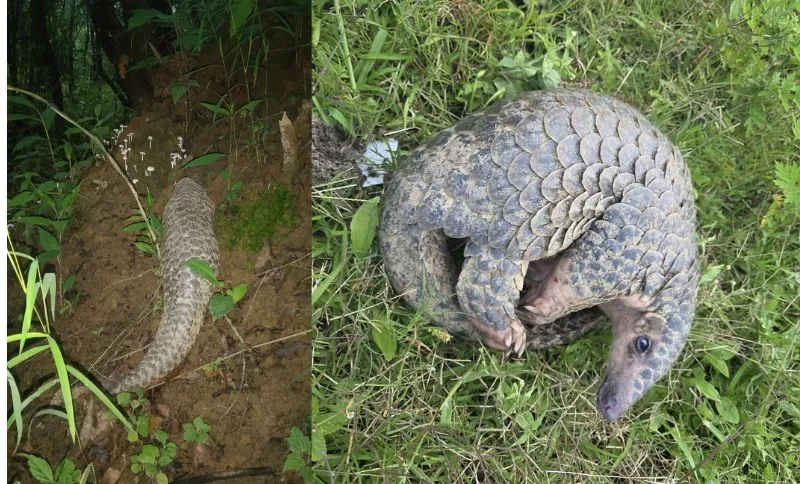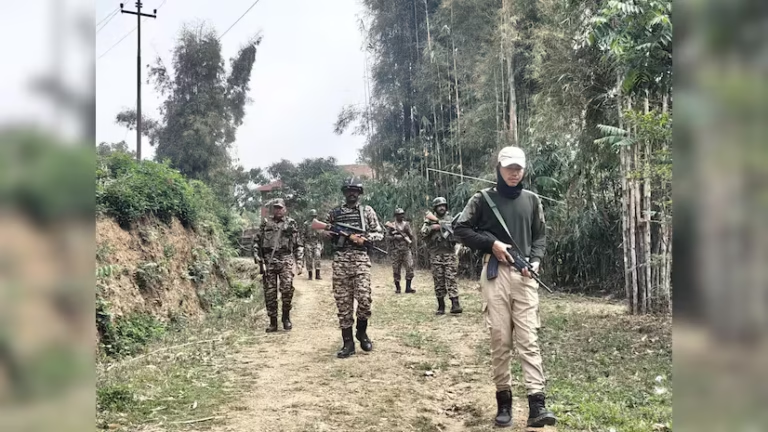A Community Triumph: Rescuing the Endangered Pangolin in Senapati
Short Summary
A critically endangered Chinese pangolin (Manis pentadactyla), locally called Shaphu, was found stranded by farmer Joseph Kaba in Sadim Malingli village in Manipur’s Senapati district. A joint team from the Senapati Forest Department, the Sadim Pukhri Village Authority, and veterinarian Dr. Chang L. rescued and medically assessed the animal. Once it was deemed healthy, the pangolin was released back into the wild, in alignment with India’s Wildlife Protection Act of 1972. The rescue highlights the power of community-driven wildlife conservation in the region
Introduction – When Compassion Meets Conservation
Have you ever wondered what happens when a farmer turns guardian for a rare wild creature? That’s exactly what unfolded in the hills of Senapati, Manipur. A pangolin—those elusive, scaly mammals that seem born out of a fantasy novel—found itself in trouble. But thanks to one person’s quick thinking and a whole community rallying behind, this pangolin got a second chance at life.
1. Who Is the Pangolin, and Why It Matters
1.1 Meet the Pangolin
Chinese pangolins are heavily armored mammals with scales—imagine an anteater wrapped in armor! They’re shy, nocturnal, and overwhelmingly endangered. Listed under Schedule I of India’s Wildlife (Protection) Act and CITES Appendix I, they face threats from illegal wildlife trade, hunting, and habitat loss.
1.2 Ecological Role
These little armored creatures pack a big ecological punch. They devour ants and termites in vast numbers, helping keep forests healthy and pest populations in check.
1.3 Conservation Status
Human demand for pangolin meat and scales—especially for traditional medicine—has made them the most trafficked mammal worldwide. Conservation groups are racing to save them before their populations vanish.
2. The Rescue at Sadim Malingli Village
2.1 How It Started
Joseph Kaba, a farmer and village chairman, discovered an injured pangolin near his fields. Recognizing its value and vulnerability, he quickly raised the alarm
2.2 Who Jumped In
The response was swift and united. The forest department teamed up with Sadim Pukhri Village Authority and local youth, plus vet Dr. Chang L. from the District Veterinary Office. A top-notch rescue squad ready for action.
2.3 The Health Check
Dr. Chang and his team meticulously examined the pangolin for injuries or diseases. Only when it was deemed healthy was it allowed back into nature—excellent veterinary practice and animal welfare in play
2.4 The Release
In a poignant moment, the pangolin was returned to its natural forest home—free, fit, and another chance at survival.
3. The Power of Local Communities
3.1 Farmers as First Responders
Joseph’s involvement is a game-changer. Often farmers are the first to find injured wildlife—but aren’t always equipped or motivated to act. His initiative made all the difference.
3.2 Youth and Village Leadership Unite
Sadim Pukhri’s villagers aren’t new to conservation. For over a decade, they’ve actively preserved the Sadim Lizai Lake forest, led by local youth and students—part of the Sadim Lizai Students and Youth Association (SLSYA)
3.3 A Model of Community Stewardship
When a village authority, farmers, youths, vet services, and forest staff synchronize, rescue missions become real. Empowered communities can become wildlife’s first line of defense.
4. Laws, Policies & Conservation Frameworks
4.1 The Wildlife Protection Act, 1972
Chinese pangolins are protected under Schedule I, granting them the highest legal shield in India. Offenders can face severe fines and jail time.
4.2 CITES Appendix I
Internationally, pangolins are off-limits for international trade. This incident aligns with legal protocol: rescue, health check, and release.
4.3 Community Conservation in Action
The village’s involvement echoes national policy: local management is pivotal. Forest departments can only do so much without grassroots cape.
5. Why This Rescue Is a Big Deal
5.1 One Success Story, Countless Ripples
Hope is contagious. This rescue can inspire other villages to act, and shy creatures could find more chances for survival across the region.
5.2 A Wake-up Call for Wildlife Conflict
Wildlife often wanders into farms because their habitat is shrinking. Joseph’s rescue points to the importance of compassion in handling wildlife conflicts.
5.3 Policy Shift in Progress
Stories like this justify policies that support human-wildlife coexistence, including funding for rescue training, vet outreach, and educational materials.
6. Pangolins in Manipur: Past and Present
6.1 Historic Panic: Poaching & Trade
Manipur, sharing borders with Myanmar, is a transit corridor for pangolin traffickers. In 2024, more than 230 local villages signed binding resolutions to ban pangolin hunting
6.2 Local Rescues & Awareness
This rescue isn’t an isolated event. In Kamjong and other parts, farmers have spotted pangolins, alerted authorities, and helped return them home
6.3 Changing Mindsets
With tribal bodies like Tangkhul Naga Awunga Long (TNAL) banning pangolin hunting, and sustained local engagement, there’s reason to hope for wild pangolins yet.
Conclusion – A Scaly Hero of Senapati
What began as a simple rescue in a sleepy village became a loud statement—for wildlife, for community spirit, for laws that truly protect. When a farmer spots a unique creature and alerts authorities; when youth groups, forest rangers, and vets show up together—that’s when conservation shifts from policy books to real forests.
This pangolin’s journey from vulnerability to freedom offers a hopeful narrative—proof that each person, each village, and each rescue can tip the scales toward survival, not extinction.
FAQs
1. What kind of pangolin was rescued in Senapati?
A Chinese pangolin (Manis pentadactyla), also called Shaphu in Meitei, a critically endangered species under Schedule I of India’s Wildlife Protection Act
2. How was the pangolin rescued and checked for health?
Local farmer Joseph Kaba alerted forest authorities. A rescue team including a veterinarian assessed it thoroughly and, once healthy, released it into the wild
3. Why is community involvement crucial in such rescues?
Local people are often first to encounter displaced wildlife. Their timely reporting and care are arguably the most essential elements for a successful rescue.
4. What laws protect pangolins in India?
They’re listed under Schedule I of the Wildlife Protection Act, 1972—the highest level of protection—and included in CITES Appendix I, banning international trade.
5. How can villages get involved in conserving pangolins?
They can form local conservation committees, set up rescue protocols, raise awareness through schools and media, and collaborate with forest departments for training and funding.




